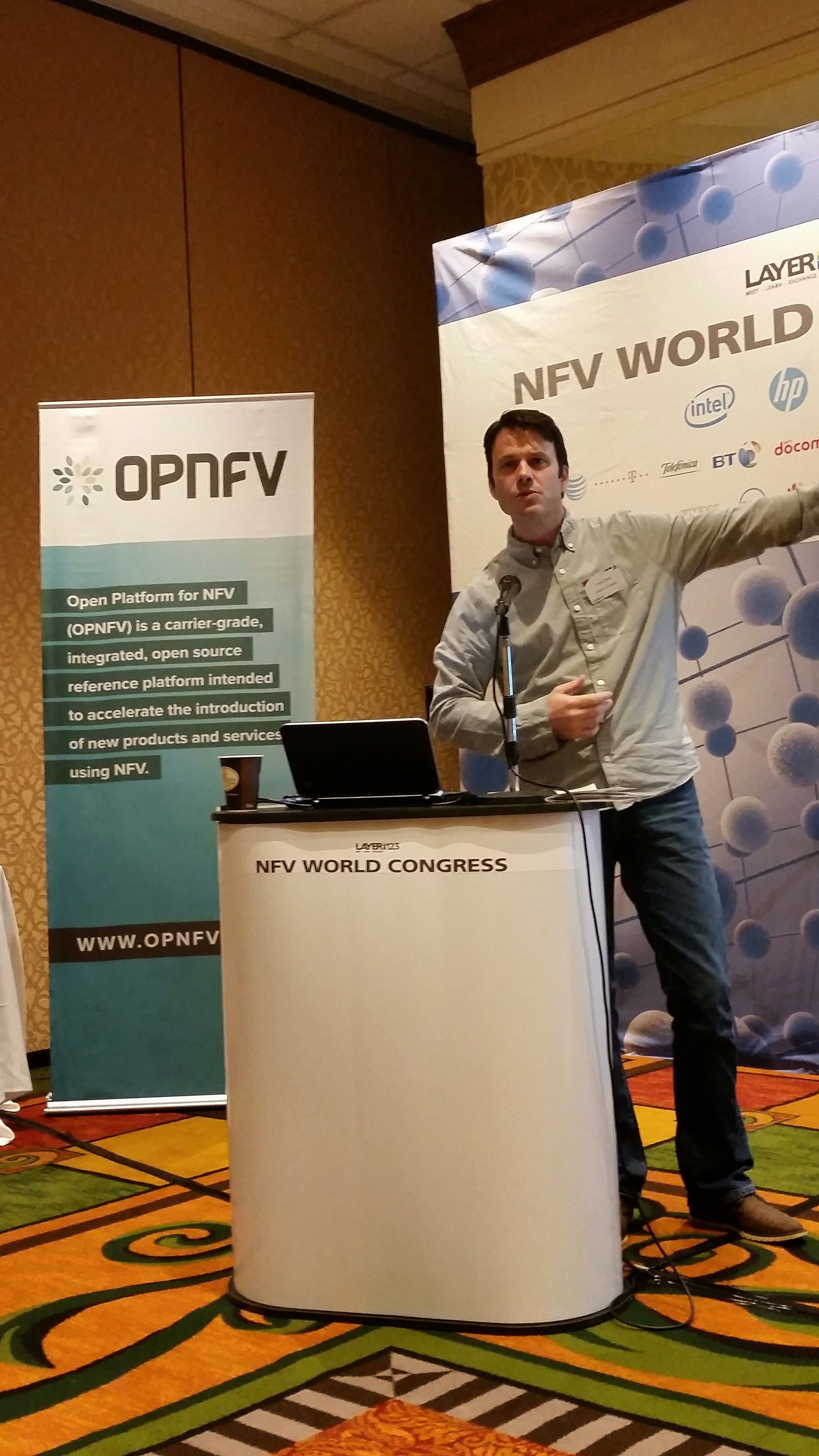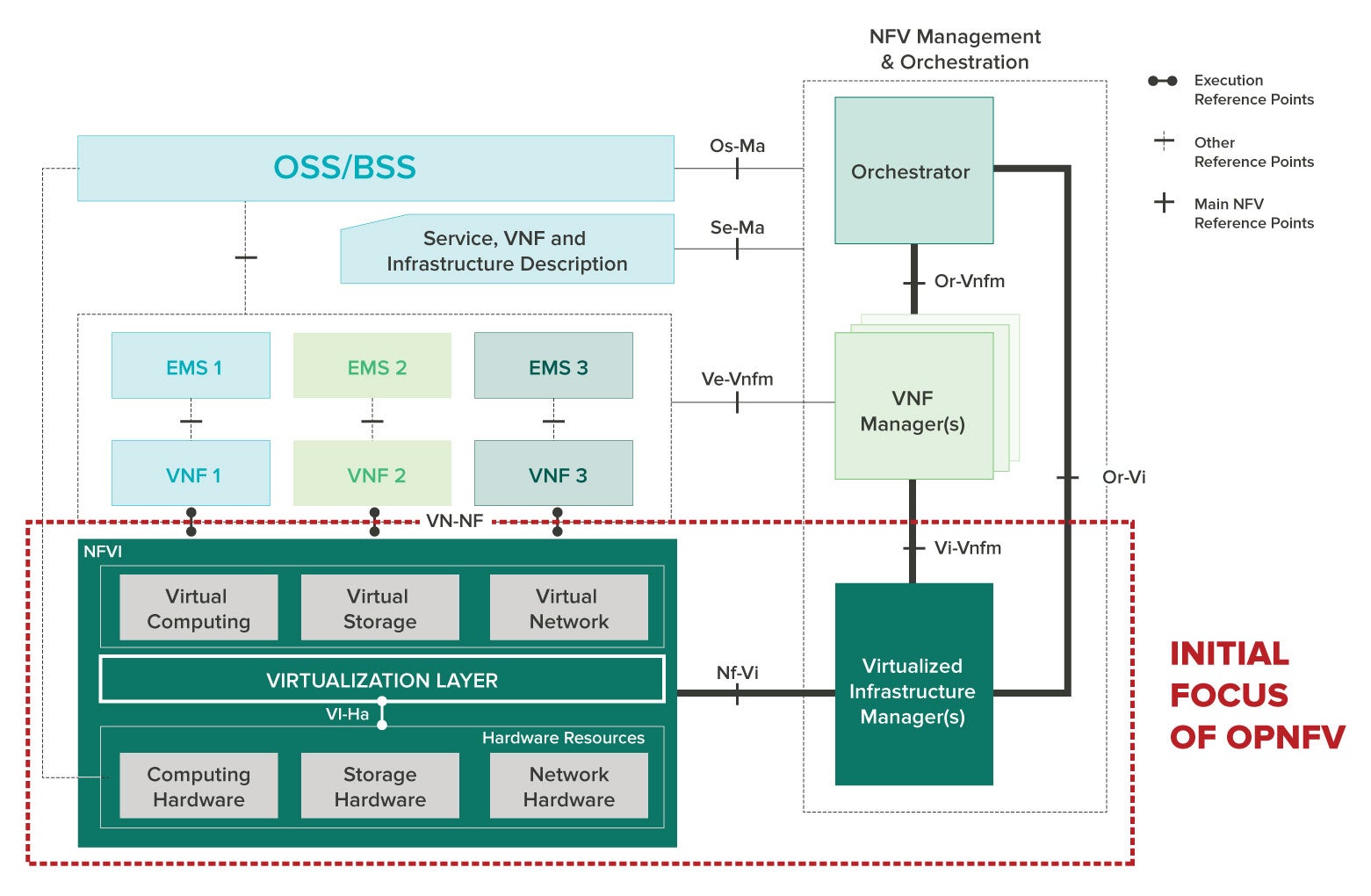Eight months ago OPNFV began uniting the networking industry around a mission to bring NFV from specification to implementation. Because the challenges facing us as an industry around NFV are so complex we realized none of us could go it alone and that collaboration is key. We require participation from a broad range of perspectives in order to create a common platform that can be woven into the fabric of any network and operate at scale. OPNFV has created a place where users and vendors can solve this problem by working on integration, testing, deployment, and infrastructure issues together. The current of interest is growing stronger with an increasing number of people wanting a voice in our community and a seat at the member table.
Today we are pleased to share the first milestone in this united effort–the availability of OPNFV Arno, the industry’s first open source platform for NFV. What this first release does is give all of us an early look at what the future can hold for NFV. Today you can download OPNFV Arno, start tire-kicking basic NFV use cases, and even trying out Virtual Network Functions (VNFs) on top of the platform and and we hope that you do. Our community will benefit from your early experiences, feedback and input so we can iterate further and release faster. As a user, please share your feedback to opnfv-users@lists.opnfv.org. If you’re a developer, join the mailing lists or weekly technical calls to help shape the direction of OPNFV.
While the code milestone is significant, an even more important accomplishment is the foundation and process we’ve built for future work. Forming a passionate community, establishing our continuous integration tool chain and processes, launching our bare metal data center and community lab program, and developing working relationships with upstream industry partners–these are the strongholds that make our code better and development process more agile in the long-run. I’ve personally been inspired by the determination of our contributors and committers as they’ve worked long hours addressing bugs and troubleshooting a range of infrastructure and code issues.
Arno is a river in Italy; our release names are river-themed, a decision made by the community, inspired in part because of the “upstream” work we are doing as a project. In open source, working “upstream” means you contribute your code back to the main source rather than forking or branching it. The OPNFV community uses code from a range of different open source projects (e.g. Ceph, KVM, OpenDaylight, OpenStack, Open vSwitch), integrates those components into an end-to-end platform, and contributes changes back to the upstream groups. Work in open source is based on trust, so building trust among these communities is always primary goal. We benefit from their knowledge and open R&D in their areas of expertise, which allows us to be laser-focused on NFV.
As William Shakespeare said, “We know what we are, but know not what we may be.” Today is a milestone for OPNFV and the industry, but it is the first of many to come. We are on a journey to transform global telecommunications infrastructure and we hope you’ll join us.
Comments from Alcatel-Lucent
“The CloudBand team has long been a staunch supporter of the open source approach to networking,” said Ron Haberman, vice president and general manager CloudBand, Alcatel-Lucent. “We believe that NFV drives new possibilities for the telecommunications industry and that the true way in which rapid progress can be made is through openness and collaboration.”
Comments from ARM
“The community spirit of OPNFV is driving a unique level of industry collaboration, enabling significant momentum to address the broad set of challenges that must be solved for NFV to be realized,” said Charlene Marini, Vice President, Networking Segment Marketing at ARM. “The Arno release is an important step in building infrastructure for a common software platform that can scale across diverse topologies and silicon architectures to enable an intelligent flexible cloud for efficient NFV infrastructure.”
Comments from AT&T
“OPNFV is working diligently to accelerate the industry build and continuous integration and build of the NFV platform. And AT&T is looking forward to the progress. Arno is the first step in this direction. The networking industry has become more comfortable collaborating in an open forum to create common approaches. In the future, common use cases, traffic profiles and benchmarks, along with automated testing on an integrated build environment like ARNO will help advance the NFV platform.”
Comments from Brocade
“Service Provider and Enterprise customers are looking to the vendor community to deliver unified, highly reliable, saleable and open solutions for the next era of networking and OPNFV’s first release is a direct response to their demands,” said Ken Cheng, CTO of Brocade and a member of the OPNFV Board of Directors. “We believe this is a critical first step in driving broad adoption of NFV and open source infrastructure solutions when combined with OpenDaylight and OpenStack.”
Comments from China Mobile
“We are extremely excited to witness the successful release of Arno in OPNFV,” said Yang Zhiqiang, Deputy General Manager, China Mobile Research Institute. “As the very first deliverable release, Arno marks a significant milestone of OPNFV on its goal of offering an integrated and open source NFV platform. This release will energize the whole NFV community and further speed up the development of NFV industry.”
Comments from Cisco
“When looking to implement NFV, there is a need to deploy a service with an easy way to operate as a service chain. We need a common platform integrating several open source projects to move this forward with our partners, said Dave Ward, Chief Architect, Cisco. “The OPNFV Arno release is a first step in the right direction to drive open source projects that support a platform for developers and the community.”
Comments from Dell
“Dell is committed to developing solutions based on open standards and open source to provide customers with flexible solutions today and tomorrow,” said Jai Menon, Chief Research Officer and Vice President, Dell Research. “The advancement of NFV using open standards and open source is leading to more agile, efficient network infrastructures, which will help create new business models. The OPNFV Arno release is a critical step towards an open source software foundation to power a vibrant ecosystem.”
Comments from Dorado Software
“The potential of NFV is closely tied to the ability to manage the diverse areas of rapid innovation that contributes to its success. A key success factor is having a common technology baseline to facilitate both collaboration and differentiation,” said Chris Simon, Vice President, Service Provider and NFV Business Unit. “Dorado looks forward to leveraging OPNFV’s Arno release to offer service providers immediate solutions for their end-to-end NFV service orchestration needs.”
Comments from ENEA
“The Arno release is a welcome first stab at a turnkey installation process allowing creation of NFV software platforms”, said Daniel Forsgren, SVP Product Management, Enea. “As Silver members, Enea has already leveraged the OPNFV project creating the first ARM-based OPNFV reference platform. With an intent to be a key contributor in the open source community we will upstream as much as possible of that work to the OPNFV baseline.”
Comments from Ericsson
“The on-going progress of NFV architecture is opening up new opportunities in the network. Ericsson is pleased to contribute to the OPNFV project and other open source collaborations to continue this progress,” said Magnus Furustam, Head of Product Area Cloud Systems at Ericsson. “We see the release of Arno as an important step in realizing the benefits of the NFV architecture.”
Comments from HP
“One of the major goals for creating OPNFV was to accelerate implementation and interoperability,” said Prodip Sen, CTO, NFV at HP. “The goal was to use the open source collaborative model for essentially short-circuiting the typical long telecom standardization process. Now in just eight months since formation, we have been able to create an integration environment that allows automated build, deployment and testing of some of the key resource orchestration and network control components for the NFV infrastructure. This is a supreme testament to the power of the collaborative community model and the strength of the vibrant NFV ecosystem I and validates the new path to standardization.”
Comments from Huawei
“OPNFV helps accelerate the maturity of NFV, which enables the operators and vendors to achieve great successes.” said Mr. Weimin Ying, Huawei NFV Leader and President of Wireless R&D. “Huawei considers the OPNFV community very important and the Arno release is a significant milestone achievement. Huawei will continue to contribute to OPNFV and help our customers and partners to succeed”.
Comments from Intel
“NFV is already demonstrating the ability to reshape network infrastructure business models for agility and efficiency. Intel is investing in technology innovation, ecosystem building, and deep industry engagements to deploy solutions that will transform the network,” said Sandra Rivera, Vice President, Data Center Group and General Manager, Network Platforms Group, Intel Corporation. “The OPNFV Arno release represents a critical advancement towards an integrated, standardized open source platform that will accelerate the pace of NFV adoption.”
Comments from Juniper Networks
“Juniper Networks is pleased to be part of the OPNFV standards body supporting the Arno release,” said Paul Obsitnik, vice president of Service Provider Marketing for Juniper Networks. “We believe this is a foundational step towards realizing business value from NFV and driving greater innovation in service provider and enterprise networks.”
Comments from NTT DOCOMO
“OPNFV has grown into a global center of the industry for the development of a common NFV platform. It plays a crucial role in accelerating the market delivery of interoperable NFV solutions,” said Hiroshi Nakamura, Senior Vice President and Managing Director of R&D Strategy Department, NTT DOCOMO, INC. “We are really excited about Arno, the first software release from OPNFV, and truly appreciate the dedicated efforts of the developers and the whole OPNFV community. We are looking forward to OPNFV to further progress and succeed with the support from the community.”
Comments from NEC
“An Open Platform for NFV is a key element for the success of an NFV ecosystem. NEC, as an IT and NW technology leader, has commercially delivered SDN/NFV solutions, including vEPC and vCPE, and is delighted to collaborate with its partners in the OPNFV project on creating a carrier-grade reference implementation for immediate and future operator needs” said Atsuo Kawamura, Senior Vice President, NEC Corporation. “OPNFV is the integrating platform for our Upstream First strategy, and the OPNFV Arno release is a major accomplishment. NEC is committed to continue working with our partners in OPNFV to achieve a platform that addresses important operator requirements.”
Comments from Red Hat
“Red Hat is deeply engaged in using open source and upstream collaboration to help communication service providers transform their networks. This major industry shift has taken another step forward with the OPNFV Arno release showcasing open source software as a reference implementation for an NFV platform.”
Comments from SK Telecom
“NFV has been very successful in engaging the overall telecom industry to define high level architectures and specifications”, stated Myung-Soon Park, Head of Emerging Technology R&D Center, SK Telecom. “The OPNFV Arno release is a significant first step towards materializing the specifications”, and “OPNFV will continue to play increasingly important role in accelerating timely and efficient innovative telecom solutions including 5G by defining tightly integrated and standardized environment.”
Comments from Telecom Italia
“After being among the founders of ETSI NFV ISG we were also within the starting members team of the OPNFV community. OPNFV can play a key role and might become the reference community shaping the actual NFV implementation,” said Luigi Licciardi, Head of Standard Coordination and Technology Disclosure, Global Advisory Services, Operations, Telecom Italia SpA. “In fact, as we are facing this major industry transformation in our infrastructure and in the way we will develop and operate services, the OPNFV Arno release represents a first major achievement and the completion of an important learning cycle regarding a new way of work and collaborate within the industry; this will help the trial and adoption of NFV within our companies.”
Comments from ZTE
“OPNFV collaboration allows the industry to address critical concerns up-front and build a common reference platform to innovate and provide new services much faster. The OPNFV Arno release demonstrated the collective effort and achievements of vendors and end-users to accelerate the evolution towards NFV,” said Dr. Zhao Xianming, CTO, ZTE Corporation. “ZTE continues to invest in ecosystem for NFV transformation and invites partners to join us in the ZTE Open SDN/NFV Lab to experience the solutions based on open standards and open source software.”


 Heather Kirksey
Heather Kirksey It was great to be part of the inaugural NFV World Congress last week in San Jose. On Tuesday, we hosted an
It was great to be part of the inaugural NFV World Congress last week in San Jose. On Tuesday, we hosted an  .
. It has been a whirlwind two months since I joined OPNFV in January. I recently spent three weeks on the road getting to know our community and seeing OPNFV in a broader market context, and it’s been a great experience. Our technical committee chair Chris Price wrote about our recent Meet-up and Hackfest and the only thing I’ll add to his great summary is that I was highly impressed by the passion and collaborative attitude I witnessed during those events. It’s not always an easy thing for a diverse group of people all working for different companies to come together and form a coherent community, but we are definitely on our way.
It has been a whirlwind two months since I joined OPNFV in January. I recently spent three weeks on the road getting to know our community and seeing OPNFV in a broader market context, and it’s been a great experience. Our technical committee chair Chris Price wrote about our recent Meet-up and Hackfest and the only thing I’ll add to his great summary is that I was highly impressed by the passion and collaborative attitude I witnessed during those events. It’s not always an easy thing for a diverse group of people all working for different companies to come together and form a coherent community, but we are definitely on our way. Mobile World Congress was OPNFV’s first big marketing event. We hosted a great networking reception Tuesday night, with both members and prospective members out in abundance. I overheard all sorts of thoughtful conversations about NFV and open source, and it was fun interacting with everyone in a more social environment. We topped off the event with an interactive panel discussion on “Accelerating NFV Through Open Source Software Collaboration,” moderated by OPNFV marketing chair, Sandra Rivera. Despite the venue being over a kilometer from the entrance and the timeslot being on the last day before lunch, we had a standing room only crowd. It speaks to the industry’s interest in what we are trying to accomplish! See the
Mobile World Congress was OPNFV’s first big marketing event. We hosted a great networking reception Tuesday night, with both members and prospective members out in abundance. I overheard all sorts of thoughtful conversations about NFV and open source, and it was fun interacting with everyone in a more social environment. We topped off the event with an interactive panel discussion on “Accelerating NFV Through Open Source Software Collaboration,” moderated by OPNFV marketing chair, Sandra Rivera. Despite the venue being over a kilometer from the entrance and the timeslot being on the last day before lunch, we had a standing room only crowd. It speaks to the industry’s interest in what we are trying to accomplish! See the  Chris Price
Chris Price